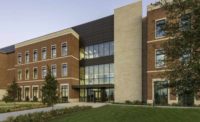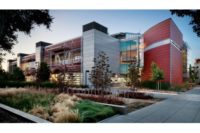Think of the last building you entered. What did it look like? How was it made? The environment we are occupy on a daily basis, including the buildings we live and work in, are constructed with functionality and aesthetics in mind. However, in this pivotal moment in time where we must act decisively to combat the adverse effects of climate change, design must also consider sustainability.
Wildfires in the West Coast are the most devastating we’ve seen, hurricanes in the Southeast are getting wetter, more dangerous, and more common, and that’s only climate change news from one week in 2020. While coronavirus has caused a temporary reduction in the amount of greenhouse gases emitted into the atmosphere, has it also put a hold on the ‘Go Green’ Initiative?
At Stephen B. Jacobs Group, we are working tirelessly to continue pushing forward and adapting green building initiatives to address climate concerns and to advance the sustainable architecture industry with our LEED Certified projects.
In the mid-1970s, we worked at the forefront of green building development, working on projects such as installing the first large flat plate solar collection system in New York City that has been providing the domestic hot water for a large adaptive reuse project for the last 40 years. Throughout my career I have witnessed the changing skyscape and design features, but one aspect I have always considered has been an emphasis on sustainability and green design. In today’s climate we’re extremely occupied trying to make sense of the current environment, but neither an unsupportive administration, nor a relentless pandemic can or should put an end to the progress made moving to a sustainable future.
Even in today’s remote working environment, our sustainable projects are moving forward. They include several projects that have been awarded or are in the process of LEED Certification, including The Edge, a recently completed thousand-unit, mixed-income project on the Williamsburg waterfront, which has become the largest residential project in this region to achieve a LEED Gold Certification. Other LEED certified projects include Village Green, Chelsea Green, Emerald Green, and Hotel X in Toronto Ontario.
Village Green is an 8-story, 36 condominium building in Manhattan’s East Village with apartments ranging from 1 bedrooms to penthouses, some boasting terraces or space for a home office, which during the coronavirus pandemic, is an important addition. The building hopes to redefine 21st Century luxury living, emphasizing the responsibility for creating sustainable living spaces. Like Village Green, Chelsea Green combines luxury living with eco-friendly design. This 14-story, 51 residence condominium development sits in the heart of Chelsea.
Chelsea Green has apartment options ranging from one to three bedrooms, and a full floor, four bedroom, penthouse with a private 2,000 square foot rooftop terrace. Our design team ensured that Chelsea Green had advanced systems in place to maximize energy efficiency, resource conservation, and improve indoor air quality. The building features solar flat panel collectors on the roof as a primary source of hot water heating, a heat recovery system that tempers cold air and delivers filtered fresh air year-round, a state-of-the-art central heating and cooling system that allows for convenient zone control, and a green roof with a rainwater irrigation system. Emerald Green, another LEED certified project in New York City from Stephen B. Jacobs Group, is a rental apartment complex featuring two 24-story towers and 569 rental units with options ranging from studio to 3-bedrooms.
Looking beyond New York City, we have also recently completed a LEED certified project in Toronto, Canada: Hotel X Toronto. The hotel overlooks Lake Ontario from a site at Exhibition Place and features 406 rooms, a conference center, sports club, retail, ballrooms and reception, a spa, two restaurants, a cinematheque, green roofs, 440 underground parking spaces, and a 10,000 square foot, three story rooftop.
Incorporating sustainability into building design does not have to be a daunting task, it can be done practically, effectively, and efficiently. Active additions like solar photovoltaic panels can help with energy efficiency, crucial during economic hardship. Passive design, such as strategic building orientation and window placement, can also play a large role in reducing energy consumption. Furthermore, material and landscaping choices may be the difference between a sustainable building and one that is intrusive to the natural environment. Using common sense, we begin to move to a sustainable future by maximizing passive orientation, using recycled materials, more insulation, and plants that are native to a given area is an easy, yet effective way to improve the sustainability of a project.
Sustainable design is practical design, with the obvious added benefit that it helps combat climate change and environmental concerns. Stephen B. Jacobs Group is continuously researching and evaluating new sustainable products that meet LEED requirements and meet our 21st Century practicality needs and aesthetic desires. Together we can push for eco-friendly design and green architecture to ensure a sustainable and clean future for all.




